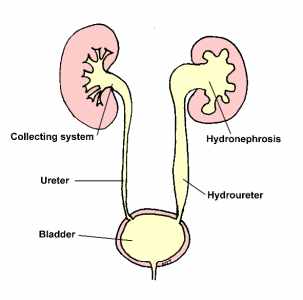

MedFriendly®


Antenatal Hydronephrosis
Antenatal hydronephrosis is hydronephrosis that is
detected before the birth of a child via ultrasound
scanning (a procedure that uses high-frequency
sound waves to produce images of internal body
structures). Hydronephrosis is a condition in which
specific parts of the kidney(s) become stretched,
swollen, and widened with urine. The kidneys are
two organs located on each side of the spine, behind
the stomach. The kidneys filter (remove) wastes
from the blood. Antenatal hydronephrosis can be
detected in the first three months of pregnancy.
FEATURED BOOK: What You Must Know About Kidney Disease
Prenatal care should not change significantly if antental hydronephrosis is identified but
is monitored with follow-up ultrasounds. Delivery occurs normally in most cases. In some
cases, the enlarged-appearing kidneys are normal after the baby is delivered. In other
cases, the condition will require continued follow-up and possible treatment.
Causes of antenatal hydronephrosis include blockage of the kidney, bladder, or urethra.
The urethra is a tube shaped structure in the body that drains urine from the bladder.
Another cause are multiple cysts that result in a kidney that does not function properly. A
cyst is an abnormal lump, swelling, or sac that contains fluid, a part solid material, or a
gas, and is covered with a membrane. See the entry on hydronephrosis for other
possible causes of antenatal hydronephrosis.
"Where Medical Information is Easy to Understand"™
Treatment of antenatal hydronephrosis will vary dependent on the
cause, such as clearing a blockage. In some cases, doctors will
remove a severely enlarged kidney. In rare cases, when there is
severe obstruction of both kidneys and low levels of amniotic fluid,
the kidneys or bladder may need to be drained with a tube or a
special operation. However, in such cases, the kidneys will not
function normally even with such a surgical procedure. Amniotic fluid
is a clear, watery, slightly yellowish fluid that surrounds and protects
the fetus in the uterus. The uterus is a hollow organ in a female's
body where the egg is implanted and the baby develops. See the
entry on hydronephrosis for more information on treatment of
antenatal hydronephrosis.

Antenatal hydronephrosis is also known as congenital hydronephrosis. Antenatal hydronephrosis comes
from the Latin word "ante" meaning "before," the Greek word "hydro" meaning "water," the Greek word
"nephros" meaning "kidney," and the Greek word "osis" meaning "condition." Put the words together and
you get "before water kidney condition."














